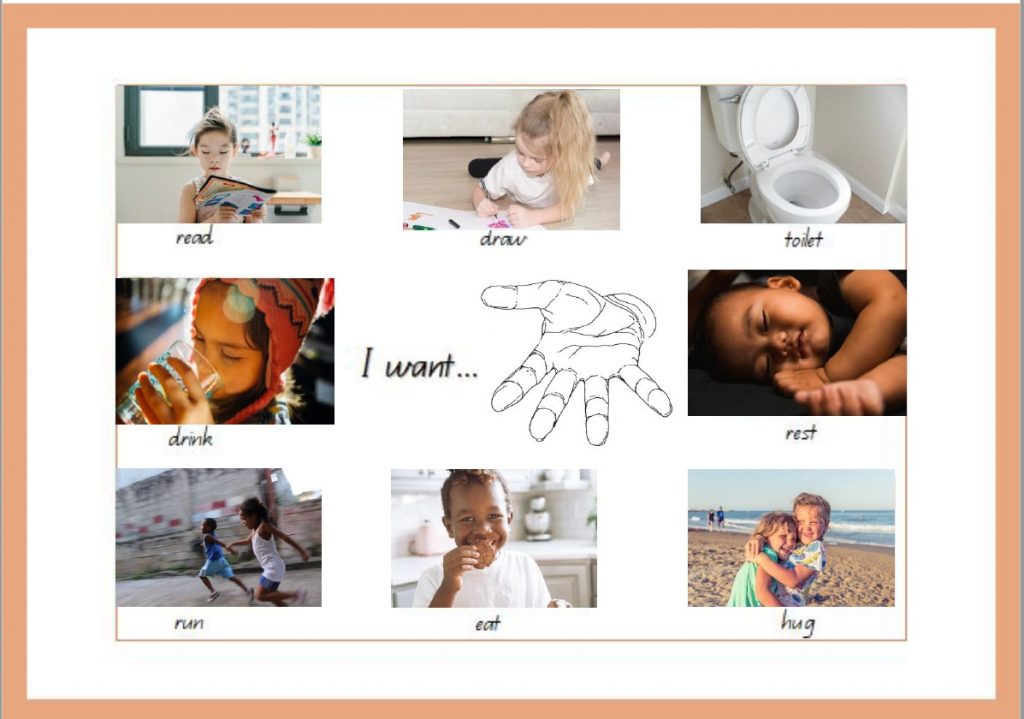22 Communicating needs
Harriet McCarron

Download the resource: McCarron Intercultural
The resource is designed to create a supportive language learning environment for children who have English as an additional language or dialect. Children can use this resource to communicate wants or needs in their early learning setting. This resource can also be used in the home, to enhance the child’s understanding and both educators and parents should hold sufficient knowledge about the meaning of the symbols. The educator can communicate with the parents and assist them to understand when to use the resource by demonstrating how to use it. The children can communicate their needs for toileting, eating and drinking, napping, hugging, indoor playing, and outdoor playing by pointing to a picture and the educator responds verbally to help the child develop the appropriate language for the need. Using a communication method allows children to be clear in communicating their agency through images of needs and wants (Ashman, 2015).
The child can independently select the language they wish to use from what they hear the educator and their peers say. The biggest challenge in supporting children learning to communicate using symbols is the need to predict and provide sufficient vocabulary to both meet their present communication requirements and stimulate further development (Ashman, 2015). My resource may be utilised in the home and learning context to ensure the child is understanding the reason for the symbol in alternative contexts.
Only a handful of early learning resources depict the full range of Australian cultures and languages. This invisibility or visibility in the classroom’s physical environment undermines some young children’s positive sense of self, while teaching other children that they are especially deserving (USQ, 2020). The resource therefore features a range of multicultural children that would be seen in an early years setting to increase the sense of belonging for all children.
Links
Early Years Learning Framework (DEEWR, 2009).
- Outcome 1: Children have a strong sense of identity
- 1.1 Children feel safe, secure, and supported
- 1.2 Children develop their emerging autonomy, inter-dependence, resilience
- Outcome 2: Children are connected with and contribute to their world
- 2.1 Children develop a sense of belonging to groups and communities
- 2.2 an understanding of the reciprocal rights and responsibilities necessary for active community participation
- Outcome 5: Children are effective communicators
- 5.1 Children interact verbally and non-verbally with others for a range of purposes
Queensland Kindergarten Learning Guideline (QCAA, 2018)
- Wellbeing: Exploring ways to be healthy and safe, Exploring ways to promote physical wellbeing
- Communicating: Exploring and expanding language; Exploring literacy in personally meaningful ways
National Quality Standard (ACECQA, 2018)
- Quality Area 1: Educational program and practice
- 1.1.2 Child-centred: Each child’s current knowledge, strengths, ideas, culture, abilities and interests are the foundation of the program.
- 1.1.3 Program learning opportunities: All aspects of the program, including routines, are organised in ways that maximise opportunities for each child’s learning.
- 1.2.3 Child directed learning: Each child’s agency is promoted, enabling them to make choices and decisions that influence events and their world.
- Quality Area 5: Relationships with children
- 5.1.1 Positive educator to child interactions: Responsive and meaningful interactions build trusting relationships which engage and support each child to feel secure, confident and included.
- 5.2.2 Self-regulation: Each child is supported to regulate their own behaviour, respond appropriately to the behaviour of others and communicate effectively to resolve conflicts.

